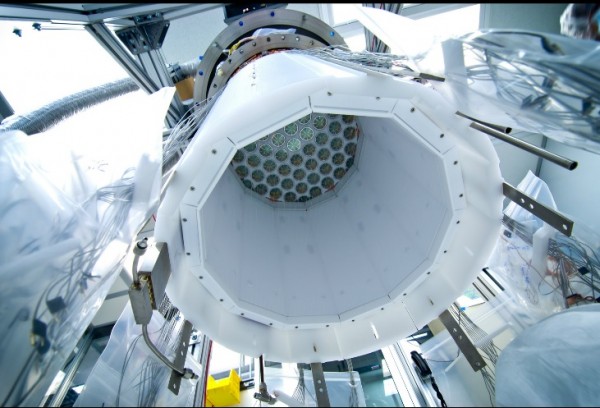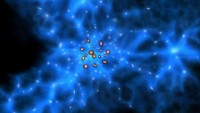World's Most Sensitive Dark Matter Detector Now 20 Times More Powerful
| Ana Verayo | | Dec 15, 2015 06:10 AM EST |
(Photo : C.H. Faham/LUXdarkmatter.org) The above volume will be filled with liquid xenon at a temperature of -100 C. Any interaction in this volume, however small, will be detected by the photomultiplier tube arrays (top visible only, bottom not yet installed).
A new complex scientific instrument has been finally upgraded that can now help scientists to gain more crucial insights about what the universe is composed of.
This instrument is known as the Large Underground Xenon or the LUX detector which is located one mile underground, in a mine in South Dakota, United States.
Like Us on Facebook
The main goal of the LUX detector is to search for tiny particles that can provide clues about dark matter, which is the powerful, invisible material that makes up about 95 percent of the entire universe.
Scientists are still trying to figure out the elusive properties of dark matter as these have only been observed indirectly, via gravitational waves that control the rotation of galaxies and how light bends via gravitational lensing as it travels across light years.
This new upgrade is pivotal, as this will also increase the detector's chances of identifying certain subatomic particles known as WIMPs or weakly interacting massive particles, which scientists claim to be the main component of dark matter.
Now, this team of physicists and researchers from the University of Edinburgh in Scotland have developed the ability of LUX to detect even the faintest form of WIMPs, making it more sensitive by 20 times.
With this new ability, scientists are now able to examine and investigate data that are consolidated from the LUX's initial run back in 2013. These WIMPs are challenging to find since they rarely interact and collide with regular matter, where their faint signals are usually overwhelmed by stronger cosmic radiation emanating from space.
According to Alex Murphy from the University of Edinburgh's School of Physics and Astronomy, after the first run of LUX, the team developed several new calibration methods and techniques to improve analysis. The team can now investigate and examine the telltale signs of WIMPs within data that were previously ignored, that can also increase chances of dark matter detection.
The reason why LUX is located deep with the Earth so that only a few cosmic beams can penetrate, as scientists use a tank of liquid xenon, surrounded in sensitive light detectors. The machine is devised to detect these collisions among WIMPs and xenon atoms inside.
When a collision occurs, the xenon atom can show a small flicker of light that can be spotted by LUX sensors. This new upgrade is also supported by the U.S. Department for Energy and the National Science Foundation.
Tagsdark matter, LUX detector, Large Underground Xenon detector, dark matter detector, world's most sensitive dark matter detector, WIMPs
©2015 Chinatopix All rights reserved. Do not reproduce without permission
EDITOR'S PICKS
-

Did the Trump administration just announce plans for a trade war with ‘hostile’ China and Russia?
-

US Senate passes Taiwan travel bill slammed by China
-

As Yan Sihong’s family grieves, here are other Chinese students who went missing abroad. Some have never been found
-

Beijing blasts Western critics who ‘smear China’ with the term sharp power
-

China Envoy Seeks to Defuse Tensions With U.S. as a Trade War Brews
-

Singapore's Deputy PM Provides Bitcoin Vote of Confidence Amid China's Blanket Bans
-

China warns investors over risks in overseas virtual currency trading
-

Chinese government most trustworthy: survey
-

Kashima Antlers On Course For Back-To-Back Titles
MOST POPULAR
LATEST NEWS
Zhou Yongkang: China's Former Security Chief Sentenced to Life in Prison

China's former Chief of the Ministry of Public Security, Zhou Yongkang, has been given a life sentence after he was found guilty of abusing his office, bribery and deliberately ... Full Article
TRENDING STORY

China Pork Prices Expected to Stabilize As The Supplies Recover

Elephone P9000 Smartphone is now on Sale on Amazon India

There's a Big Chance Cliffhangers Won't Still Be Resolved When Grey's Anatomy Season 13 Returns

Supreme Court Ruled on Samsung vs Apple Dispute for Patent Infringement

Microsoft Surface Pro 5 Rumors and Release Date: What is the Latest?













